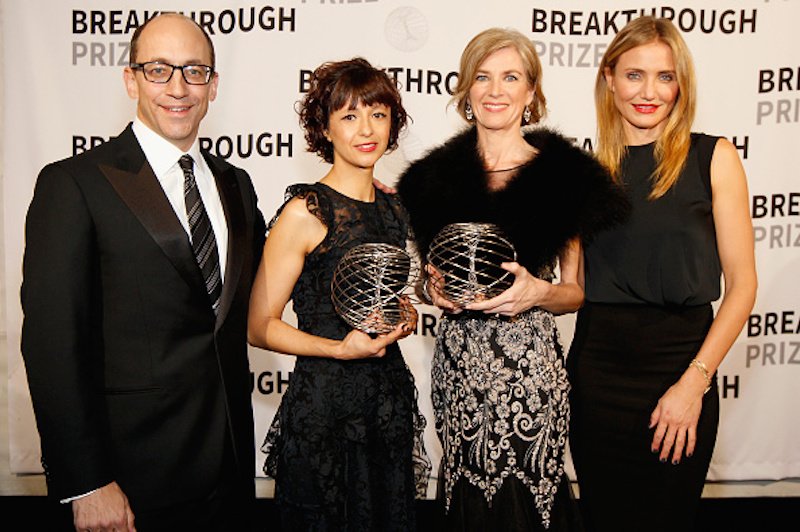
The biggest biotech discovery of the century is about to change medicine forever
Carl Zimmer
From left to right, Twitter CEO Dick Costolo, Ulmea University professor and Microbologist Emmanuelle Charpentier, UC Berkeley Professor of Chemistry Jennifer A. Doudna, and actress Cameron Diaz attend the Breakthrough Prize Awards Ceremony at NASA Ames Research Center on November 9, 2014 in Mountain View, California.
On a November evening last year, Jennifer Doudna put on a stylish black evening gown and headed to Hangar One, a building at NASA’s Ames Research Center that was constructed in 1932 to house dirigibles.
Under the looming arches of the hangar, Doudna mingled with celebrities like Benedict Cumberbatch, Cameron Diaz and Jon Hamm before receiving the 2015 Breakthrough Prize in life sciences, an award sponsored by Mark Zuckerberg and other tech billionaires.
Doudna, a biochemist at the University of California, Berkeley, and her collaborator, Emmanuelle Charpentier of the Helmholtz Centre for Infection Research in Germany, each received $3 million for their invention of a potentially revolutionary tool for editing DNA known as CRISPR.
Doudna was not a gray-haired emerita being celebrated for work she did back when dirigibles ruled the sky.
It was only in 2012 that Doudna, Charpentier and their colleagues offered the first demonstration of CRISPR’s potential.
They crafted molecules that could enter a microbe and precisely snip its DNA at a location of the researchers’ choosing.
In January 2013, the scientists went one step further: They cut out a particular piece of DNA in human cells and replaced it with another one.
In the same month, separate teams of scientists at Harvard University and the Broad Institute reported similar success with the gene-editing tool.
A scientific stampede commenced, and in just the past two years, researchers have performed hundreds of experiments on CRISPR. Their results hint that the technique may fundamentally change both medicine and agriculture.
Some scientists have repaired defective DNA in mice, for example, curing them of genetic disorders. Plant scientists have used CRISPR to edit genes in crops, raising hopes that they can engineer a better food supply.
Some researchers are trying to rewrite the genomes of elephants, with the ultimate goal of re-creating a woolly mammoth.
Writing last year in the journal Reproductive Biology and Endocrinology, Motoko Araki and Tetsuya Ishii of Hokkaido University in Japan predicted that doctors will be able to use CRISPR to alter the genes of human embryos "in the immediate future."
Thanks to the speed of CRISPR research, the accolades have come quickly. Last year MIT Technology Review called CRISPR "the biggest biotech discovery of the century."
The Breakthrough Prize is just one of several prominent awards Doudna has won in recent months for her work on CRISPR; National Public Radio recently reported whispers of a possible Nobel in her future.
Even the pharmaceutical industry, which is often slow to embrace new scientific advances, is rushing to get in on the act. New companies developing CRISPR-based medicine are opening their doors.
In January, the pharmaceutical giant Novartis announced that it would be using Doudna’s CRISPR technology for its research into cancer treatments. It plans to edit the genes of immune cells so that they will attack tumors.
But amid all the black-tie galas and patent filings, it’s easy to overlook the most important fact about CRISPR: Nobody actually invented it.
Doudna and other researchers did not pluck the molecules they use for gene editing from thin air. In fact, they stumbled across the CRISPR molecules in nature.
Microbes have been using them to edit their own DNA for millions of years, and today they continue to do so all over the planet, from the bottom of the sea to the recesses of our own bodies.
We’ve barely begun to understand how CRISPR works in the natural world.
Microbes use it as a sophisticated immune system, allowing them to learn to recognize their enemies. Now scientists are discovering that microbes use CRISPR for other jobs as well.
The natural history of CRISPR poses many questions to scientists, for which they don’t have very good answers yet.
CONTINUE READING AND VIEW VIDEO.......
http://investorshub.advfn.com/boards/read_msg.aspx?message_id=111019813

